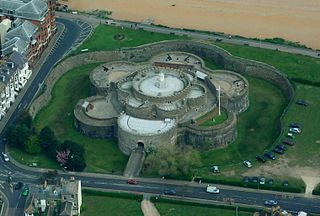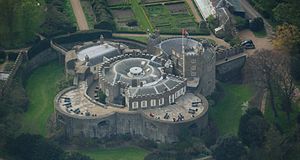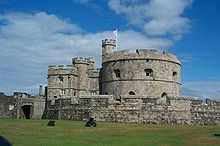- Device Forts
-
The Device Forts, also known as Henrician Castles, are a series of artillery fortifications built to defend the southern coast of England by Henry VIII. After his divorce of Catherine of Aragon England was left politically isolated, and the peace of Nice between France and Spain in 1538 aroused fears of invasion.[1] This threat stimulated the beginning of the first phase of the largest defence programme since Saxon times. This first phase was known as the 1539 device programme which was followed after renewed threats from the French by a second programme, the 1544 device programme. Henry’s coastal defences ranged from earthen bulwarks to small blockhouses and artillery towers to state of the art Italianate style fortifications. Henry took a personal interest in the military engineering techniques of the time, and approved and amended the designs himself. Although they were built to defend England during Henry’s reign, many of them were used in the English Civil War and were refortified at various times during the Napoleonic wars, First and Second World Wars.
Contents
1539 Device programme
Before building coastal defences around southern England, Henry VIII built fortifications in the north of the country, although much of his work no longer survives. Most of the work was making additions to existing castles to modernise them, as was done at Carlisle and Berwick-on-Tweed.[2] In 1534 the Act of Supremacy passed by the Parliament of England made Henry VIII the head of the English church, challenging the authority of the papacy. Pope Paul III negotiated a peace in 1538 between Charles V, the Holy Roman Emperor, and King Francis I of France. The peace threatened England,[3] and in response Henry VIII undertook a programme of building forts along England's south coast.[4]
In the first phase of Henry’s fortification programme 30 castles or forts were built. A curvilinear form of fortification was developed which consisted of squat artillery towers surrounded by round bastions to provide platforms for artillery. Good examples of these are Walmer Castle and Deal Castle in Kent, Calshot Castle and Hurst Castle in Hampshire and St Mawes Castle in Cornwall. The Castles of the Downs consisted of Deal Castle, Sandown Castle, Kent and Walmer Castle, which created a defensive line to protect the good landing grounds and strategic anchorage between the Goodwin Sands and the coast (known as the Downs). They were linked by earthworks and bulwarks to provide further defence along this important stretch of coastline.
1544 Device programme
This was begun after renewed threat from the French in the 1540s and concentrated on the vulnerable area around the Solent estuary and the Southampton and Portsmouth ports.
This later programme of coastal defences reflect new developments in fortifications, especially in the introduction of Italianate designs of the use of angular features. The earlier curvilinear designs of castles were replaced by square keeps surrounded by angular or arrow-head shaped bastions. Good examples of these are Yarmouth Castle and Southsea Castle built around 1545. In 1547–8, an inventory was made of crown possessions and this details the cannon and hand-arms of each fort.[5]
List of Henrician castles
Some of the key forts or castles are:
Name County Date Brownsea Castle Isle of Wight 1545–1547 East Cowes Castle Isle of Wight 1539–42 Sandown Castle Isle of Wight 1545 Sharpenode Bulwark Isle of Wight 1545–1547 St Helens Bulwark Isle of Wight 1539–45 West Cowes Castle Isle of Wight 1539–40 Worsleys castle Isle of Wight 1522–5 Yarmouth Castle Isle of Wight 1545 Calshot Castle Hampshire 1539–40 Hurst Castle Hampshire 1541–44 Netley Castle Hampshire 1542–45 St Andrews Castle Hampshire 1543–44 Southsea Castle Hampshire 1538–44 Sandsfoot Castle Dorset 1541 Portland Castle Dorset 1539–40 Camber Castle Sussex 1513–43 Deal Castle Kent 1539 Sandgate Castle Kent 1539–40 Sandown Castle Kent 1539–40 Walmer Castle Kent 1539 Gravesend Blockhouse Kent 1539 Higham Blockhouse Kent 1539 Milton Blockhouse Kent 1539 East Tilbury Blockhouse Essex 1539–41 West Tilbury Blockhouse Essex 1539 Pendennis Castle Cornwall 1540–5 Little Dennis Blockhouse Cornwall 1544–6 St Mawes Castle Cornwall 1540–3 St Catherine's Castle Cornwall 1538–40 Devils Point Artillery Tower Devon 1537–39 Design
Military historian D. J. Cathcart King contrasts Device Forts with medieval fortifications, noting that "by medieval standards their profile is squat; their battlements, unpierced by loops, have rounded merlons and widely-splayed embrasures with sloping sills, to reduce damage by gunfire; and they are robustly built."[2] The early artillery forts are generally in the form of a central round tower surrounded by a variety of concentric elements. Short and squat, with normally 3 tiers of long-distance offensive armament and a couple of tiers of defensive armament. The bays had wide splays for easy traverse of the guns, walls were thick and curved to deflect shot, and the medieval portcullises, murderholes and drawbridges were perpetuated.
The later forts reflected new developments in fortifications, especially in the introduction of Italianate designs of the use of angular features. They had square keeps surrounded by angular or arrow-head shaped bastions, such as at Yarmouth.
References
- Notes
- Bibliography
- Colvin, H.M. et al. (1982). The history of the King's Works, volume 4 : 1485–1660 (Part 2)
- Elton, G.R. (1991). England Under the Tudors London: Routledge ISBN 978-0415065337.
- King, David James Cathcart (1988), The Castle in England and Wales: an Interpretative History, London: Croom Helm, ISBN 0-918400-08-2
- Harrington, Peter (2007). The castles of Henry VIII. Oxford: Osprey.
- Starkey, David, ed., The Inventory of Henry VIII, vol. 1, Society of Antiquaries, (1998), 105–144.
Further reading
- Donnelly, J. A. (1982), "A study of the Coastal Forts built by Henry VIII", Fort 10: 105–126
- Morley, B. M. (1976), Henry VIII and the development of coastal defence, London: H. M. Stationery Office, ISBN 9780116707772
External links
Device Forts Kent and Sussex Solent South West Categories:
Wikimedia Foundation. 2010.



